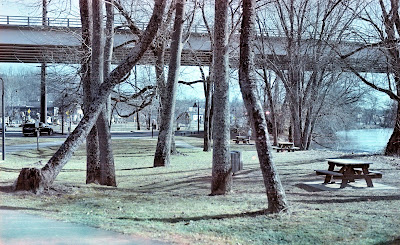Sometimes it's fun to just try things and see what happens...
My buddy Bill Pivetta gave me an unopened 1000 ft reel of 35mm motion picture stock last summer, and until recently, it sat in the fridge. I finally got around to spooling up some of that 1000 ft reel into a 35mm bulk loader, and from that, I loaded up a couple of 35mm cassettes. The “mystery film” is Eastman 5243 color internegative film. It’s been really difficult to find much information about it, except that it was used in Star Wars (1977) to produce the final negative for the positive copies for distribution. The database of film stocks indicates that this film was discontinued in the late 1950s, but that is not the case. These big reels of film appear to be relatively “recent” - perhaps from the 1980s. In any case, I was intrigued to see what I might get from this film. Knowing that similar special-purpose cine films have a low ISO, I decided on an ISO of 1.5, which is 2 stops more exposure than my F4’s lowest ISO setting. So, I just set the exposure compensation dial to +2, giving me an ISO of 1.5 for in-camera metering purposes. While shooting, I bracketed from +2 to +1 and 0, for an estimated ISO of 1.5, 3.0, and 6. On a full sunny day, sunny-16 for this film would be about 1 second at f/16, or about 1/15 sec at f/4.
I shot the roll in the River Arts District, and developed the film in C-41 chemistry along with a roll of Kodak Vision 3 500T. Before developing, I gave the two rolls a good soak in an alkaline solution of Sodium bicarbonate and Sodium carbonate, and then shook the tank like a cocktail shaker for 4 rinses to get as much remjet off the films as possible - about 99%. I then proceeded to do a typical developer and blix, followed by a series of washes.
 |
| before scanning |
The resulting negative has a greenish base, and while the base was rather dense, I could see the negatives, and my eye says the ISO 1.5 was pretty close. Scanning gave me some interesting results. For one, it’s obvious that the film has lost some color sensitivity, and I don’t know if the blue-green base color is merely the result of age - which it certainly could be, or a factor of age and storage conditions. I don’t think the film was refrigerated. The color matrix in the first image shows how the film now records colors. The grain is fine, as I would expect from an internegative film. There is some odd coloration in some frames - and perhaps that’s from age, as this was the beginning of the large roll. With some post processing in my favorite image editor (Corel Paint Shop Pro), I did some fade correction and exposure correction. The resulting colors are muted, and some people might find them very appealing.
 |
| 5243 color chart after some tweaking |
 |
| color chart as it's supposed to look (iphone) |
I don’t think there would be all that much difference had I developed the film in ECN-2 chemistry. After all, this is a special purpose, slow cine film that’s probably at least 40 years old. I may try another roll soon and see how it goes. However, that’s the beauty of testing a strange film --strange results. I don’t know if there would be enough interest for me to sell any reloaded 35mm cassettes with the 5243 film at ISO 1.5. Obviously there’s no guarantee on the results, but if you are interested in acquiring a few rolls of 5243 at a low price, let me know (USA only), as I have almost 1000 feet of it...
 |
| before any corrections |
 |
| Vision 500T, Nikon FE10. |







1 comment:
hi! i’m interested in a few rolls of the film!
Post a Comment